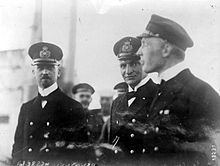Name U 53 Laid down 17 March 1915 Launched 1 February 1916 | Ordered 23 August 1914 Commissioned 22 April 1916 Construction started 17 March 1915 Draft 3.64 m | |
 | ||
Builder Friedrich Krupp Germaniawerft | ||
SM U-53 was one of the six Type U 51 U-boats of the Imperial German Navy during the First World War.
Contents
Construction and commissioning
U-53 was ordered from Germaniawerft, Kiel in 1914 and launched in 1916. She was commissioned under her first commander Hans Rose in 1916.
Service with the Imperial German Navy
Rose became the 5th ranked German submarine ace of World War I sinking USS Jacob Jones and 87 merchant ships for a total of 224,314 gross register tons (GRT). Rose's first patrol with U-53 was to Newport, Rhode Island. His mission had been to sink any British warships in position to ambush the merchant submarine Bremen; but he heard a radio broadcast on 28 September 1916 indicating Bremen had been sunk. U-53 entered Newport harbor on the morning of 7 October 1916. Rose paid courtesy visits to Rear Admiral Austin M. Knight, Commandant of the United States Second Naval District, and Rear Admiral Albert Gleaves aboard the cruiser USS Birmingham; and then received courtesy visits from both admirals aboard U-53. Admiral Gleaves brought his wife and daughter to visit U-53. It took the neutral American government about two hours to decide how to handle this surprise visit. When the harbor master started talking about quarantine regulations, Rose returned to sea to avoid being interned.
U-53 commenced military operations the next morning two miles off the Lightship Nantucket. The American steamer Kansan was stopped by a shot across the bow at 0535, and then released when examination of her papers revealed no contraband cargo. A large passenger liner was allowed to pass at 06:00 because Rose felt unable to provide for the safety of a large number of passengers. The 4,321-ton British steamer Strathdene was stopped at 06:53 and torpedoed at 07:43 after the crew had abandoned ship. The 3,878-ton Norwegian steamer Christian Knutsen with a cargo of diesel oil for London was stopped at 08:03 and torpedoed at 0953 after the crew had abandoned ship. The 3,847-ton steamer West Point was stopped at 1130 and sunk by explosive charges after the crew had abandoned ship.
Seventeen American destroyers were dispatched from Newport to search for survivors in response to the Nantucket lightship's reports of sinkings. The destroyers arrived about 1700 as U-53 stopped the Dutch steamer Blommersdyk bound for England with contraband cargo. The 3,449-ton British passenger liner Stephano was stopped and the gathering American destroyers took off its crew and passengers. Rose used his last torpedoes to sink Blommersdyk at 19:50 and Stephano at 22:30. Rose set a homeward course via the Gulf Stream and evaded three British destroyers sent from Canada to intercept him.
Political Ramifications from Trip
There was a great deal of anger amongst the Allied powers after the visit of U-53 to the American port and the subsequent sinking of Allied shipping. While all of the sinkings were done according to Prize Court laws and nobody was killed during them, the attacks instilled fear in the British because of the reach of the German U-boats, and the United States because these attacks occurred so close to American shores.
The British were further outraged that most of the attacks occurred while the submarine was surrounded by American destroyers. After a soothing speech by Sir Edward Grey, these complaints were calmed when he pointed out that the American ships had no legal right to interfere with these attacks and had done all they could to rescue the sailors in the water. German newspapers celebrated the trip as a great demonstration of the reach of the German Navy and Captain Rose was praised for his actions.
Career after voyage
In the summer of 1917 artist Claus Bergen accompanied U-53 on an Atlantic patrol, resulting in a series of well-known paintings.
Rose was relieved by von Schrader in 1918. The sub operated primarily within the English Channel after this, attacking Allied and neutral vessels. Von Schrader sank ten more ships of 1,782 tons with U-53 before the armistice on 11 November.
